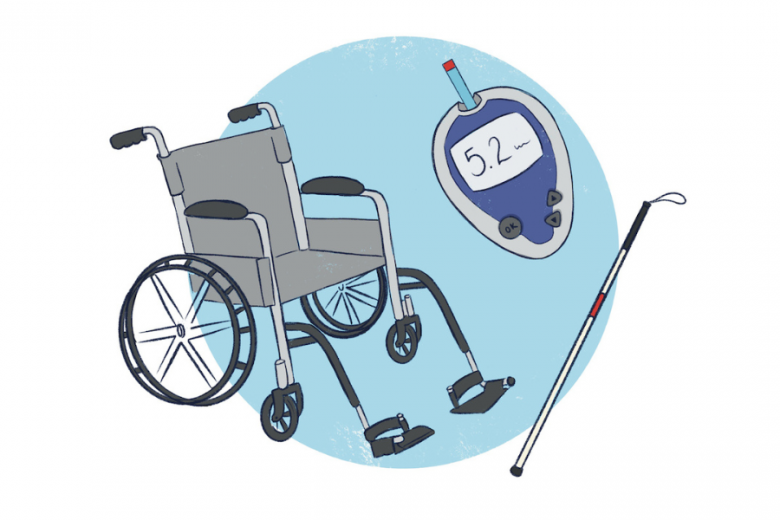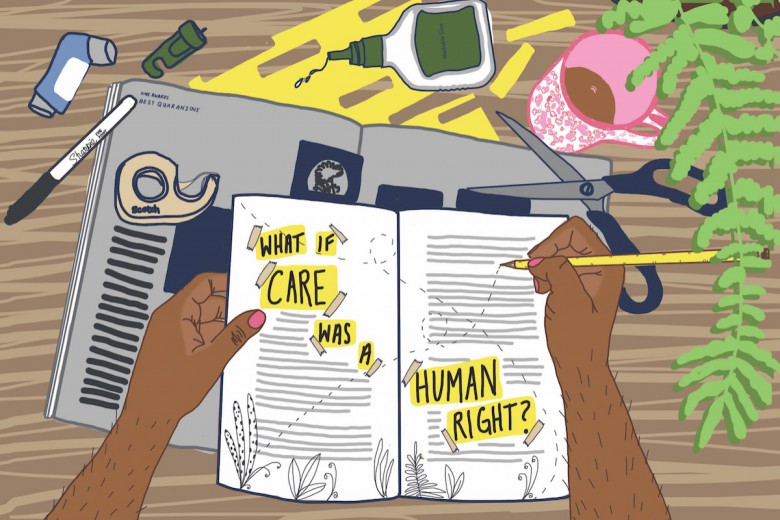
“Before this photo, I had not taken a bath since I was a child. Baths are difficult to get in and out of and are not PSW [personal support worker] friendly. Our hotel room was very accessible and when I saw this standalone bath, I wondered if the Hoyer lift [in the back left] could straddle it while I was lowered. My caregiver was more than happy to make my dream come true and be creative to strategize.” – Alessia Di Virgilio, illustrated above. Art by Bea Hayward.
After his parent caregivers died, Michal Kaliszan, a 40-year-old disabled software engineer, needed a new care plan. Kaliszan requires 24-hour care, but the Ontario government funds only six hours per day of personal support and he wasn’t likely to get additional government funding. He set up a GoFundMe which raised nearly $70,000, but Kaliszan’s home care costs around $800 a day, and the donations, while generous, would only last him three months.
He was faced with three unattractive options: the first was to be institutionalized in a long-term care home, which would require him to accept fewer hours of care per day than he’d received while living at home with his parents. He’d also be forced to give up his job because of the poor internet, rigid care schedule, and small rooms in long-term care homes. The second was medical assistance in dying (MAID), like many other disabled and older people who cannot afford home-based care supports are now being pushed to consider. His last option was to hire a live-in migrant caregiver, who might work for poverty wages and with few employment protections because of their precarious immigration status in Canada.
More than 433,000 people have unmet home-care support needs due to staffing shortages, low wages, and a lack of adequate funding.
Home care refers to a range of medical and non-medical supports – such as assistance with medication reminders, bathing, personal cooking and cleaning, and catheter care – which enables disabled people to live in their communities, and often remain in their homes, instead of living in a residential nursing home. Over 90 per cent of disabled and older people in Canada prefer to receive home care over living in a long-term care home, regardless of diagnosis or degree of care needs. It’s not hard to understand why Kaliszan might choose the third option, but it’s not the option that he, many other disabled people, and migrant justice activists would desire for anyone.
Home care remains among the most under-resourced, unregulated, and decentralized of all essential care systems in Canada. As a result, more than 433,000 people in Canada have unmet home-care support needs due to staffing shortages, low wages, and a lack of adequate funding. There is no home-care system in Ontario, but rather a web of privately operated (and publicly subsidized) programs and funding agencies that disabled, Mad, and older people are forced to navigate to meet their needs.
The austerity of Ontario’s home-care system pits receivers’ care needs against calls from migrants for decent working conditions and status for all, creating conditions that can be violent, demeaning, and debilitating for both care workers and receivers.
Home care for disabled and older people is one of the three qualifying types of caregiving jobs permitted under the Temporary Foreign Worker Program. The low wages and subsequent gaps in the labour market mean that employers pitch home-care jobs to immigrants and migrant workers as a stepping stone to health-care careers with higher wages and prestige once they get permanent resident status and Canadian citizenship.
Rather than home care being a radical alternative to disabled people’s confinement in nursing homes and a good job for migrant workers, the austerity of Ontario’s system pits receivers’ care needs against calls from migrants for decent working conditions and status for all, creating conditions that can be violent, demeaning, and debilitating for both care workers and receivers.
As organizers, former care workers, and care receivers, we – Megan Linton, Mary Jean Hande, and Ethel Tungohan – know the transformative potential of building common cause between migrant care workers and low-income home-care users. We write this article as part of the Towards Just Care project, which brings together the perspectives of low-income home-care receivers and migrant care workers to imagine a more just home-care system that doesn’t rely on global labour exploitation that displaces workers from their families and communities and that provides inadequate home-care services that endanger care receivers.
“Double-dipping”
Alessia Di Virgilio is a 43-year-old home-care recipient who has been navigating Ontario’s home-care system for over 20 years. Di Virgilio uses a ventilator and a power wheelchair, so she requires help lifting herself out of her chair and ensuring her ventilator is always within reach.
Di Virgilio’s daily life is dependent on the care of precariously employed migrant workers. When care workers arrive at her home, they have mere minutes to help her shower, get dressed, and prepare food. This rush makes it hard to develop meaningful, safe, and trusting care relationships.
“It’s like, you want a shower,” Di Virgilio explains, but “you’re not gonna get a shower because you don’t feel safe with this new person coming in.”
“I’m just trying to get [the care] I need in order to live my life.”
When some of Di Virgilio’s care doesn’t get done within the home-care worker’s strict schedule, she has to wait until her next care shift. If she tells the home-care agency, Di Virgilio says they reply, “‘Well, you chose not to shower.’ And I’m like, ‘Well, I chose to breathe.’”
Systemically poor working conditions result in a revolving door of home-care workers who leave Di Virgilio constantly looking for new caregivers, especially since the government does not provide funding to employ full-time workers.
Recently, Di Virgilio has been grieving a member of her care team who recently left the country, and she’s dreading recruiting, hiring, and being vulnerable with someone new. “I am perpetually recruiting,” Di Virgilio says. “Most people need full-time work and I think it’s difficult to provide full-time work. This is not a full-time position.”
The current home-care system “relies on exploitation to function.”
Moreover, home-care agencies have archaic and volatile policies that make it difficult for home-care receivers to access holistic care from the same provider. To patch together adequate support to meet her daily needs, Di Virgilio goes through multiple home-care agencies.
“There’s so many additional things that my care agency doesn’t cover,” she shares. For example, Di Virgilio can’t access care support for when she travels or during hospital stays. If she goes to another agency for subsidized care, the system accuses her of “double dipping.”
“I’m just trying to get what I need in order to live my life. It makes you feel so dirty when they call it ‘double dipping.’ […] It’s like you don’t deserve even what you’re getting.”
Needing care while doing care work
Both workers and care receivers bear the brunt of the system’s austerity. On the other side, some migrant care workers are forced to live in the homes of their employers, and the workers are underpaid and precariously housed and employed. They’re largely not unionized and are often pulling shifts caring for many older and disabled people through multiple agencies to weave together a barely livable income.
Val* migrated from the Philippines in 2019 as an international student at Seneca Polytechnic in Toronto. Soon after arriving, she realized she wouldn’t be able to stay in Canada after graduating, so she became a caregiver through the Temporary Foreign Worker Program’s Live-in Caregiver scheme as a path to permanent immigration status.
Due to the COVID-19 pandemic and restrictions against social gatherings, Val’s employer required her to live with them part time, and to only see her husband on weekends. She didn’t have her own living space, and the working conditions were very difficult for her mentally. When restrictions eased in 2021, she became a live-out employee, which allowed her to live with her husband again.
In lieu of a headshot, Val shares a photo she took to represent her. "Autumn whispered to the wind, I fall but always rise again." - Val
Val trained as a nurse in the Philippines, but she says her tasks as a live-in caregiver, which include cleaning a massive house and caring for multiple members of her employer’s family, are much more arduous. Some days, she’s so exhausted she cries. She likes being a caregiver, but she faces a lot of social stigma as a migrant care worker, which is devalued as a “low-status” profession. This was especially true through the peak of the pandemic, when racialized migrant home-care workers faced additional stigma and were treated as “vectors of disease.” Every single one of the immigrant home-care workers in Manitoba that Mary Jean Hande, Leah Nicholson, and Migrante Manitoba interviewed for a July 2023 report had experienced racism in their workplaces.
Not long after beginning her caregiving work, Val had a baby. “I told myself, alright I will just take a leave for three months [after giving birth], maybe, and then I’ll get back to work,” she shares. Despite spending over 40 hours per week caring for Canadians, she’s struggling to secure affordable care for her child. She found temporary care for her baby while she’s at work, but the arrangement will soon end and she has yet to find a daycare for her child that she can afford.
“It’s actually very hard to find daycare. I’ve already signed up for many daycares, but no one has responded,” she shares. “I am taking care of other people, but how about my family?” She has been struggling to find not only affordable childcare, but also elder care for both her and her husband’s parents in the Philippines.
“It’s kind of scary because you think about taking care of other people but what will happen when you grow old? How will I be able to save up money with all these responsibilities at hand or on my shoulder, because as a Filipino we have extended families?”
Val has to work full time to provide for her family, but it makes it difficult for her to take care of her own family’s needs both in Canada and in the Philippines, all the while navigating the Canadian government’s immigration policies that required 24 months of employment under Canada’s Caregiver Program to be eligible to apply for permanent residency at the time of her application. Home-care models like the Temporary Foreign Worker Live-in Caregiver Program use workers’ lack of permanent status to force them to accept this work for longer time periods – creating an unethical dependency for home-care receivers on violent immigration policies.
“It’s kind of scary because you think about taking care of other people but what will happen when you grow old? How will I be able to save up money with all these responsibilities at hand or on my shoulder, because as a Filipino we have extended families?”
Dreaming of a better future
For disabled and older people, home care is life sustaining. Many disabled people cite their lack of access to home care as a reason for contemplating MAID. The Towards Just Care project dreams of futures where people have access to the care and support they need, borders are abolished, and prisons, long-term care homes, and other institutions that confine disabled people no longer exist.
We asked Di Virgilio and Val: what would a just home-care system look and feel like? What are your dreams for the future of home care? For Val, a more just home-care system would pay her enough to take care of her baby, her parents, and her family.
Home care can be a perfect model of neoliberalism, or it can be a portal into a world with more just care and migration systems.
“Given our situations, where my parents are in the Philippines and we are here, perhaps our dream is to have enough money for their medical funds, enough money to sustain their medical needs, and for emergency, and for hospital bills. I’d like to build a business to help other people as well as to provide jobs. That’s what I really want. And then to retire early to spend more time with kids. My baby is young and we have to work, work, work, work. It’s like we’re stealing all the time we should have for her because we are working.”
With her current workload, a day off is rare. A more just care system would enable her to relax and care for herself, too. “I’m […] actually dreaming of having one day off, me time. But I can’t just do that cause there’s a lot of responsibilities, right? You have to think of a lot of people.”
Di Virgilio also dreams about relaxing, to feel “refreshed rather than drained when my care support leaves.” Current structures of care work mean that miscommunication and anxiety are endemic to the care system. In her book Just Care, Akemi Nishida builds on activist stories to explore the ways in which current care-work regimes result in “mutual and constant debilitation.”
The current home-care system “relies on exploitation to function,” Di Virgilio explains. Often those who provide care, like Val, can’t secure care for their loved ones or even for themselves. But Di Virgilio, like many other disabled and older people, want home care to be a “mutual, reciprocal exchange,” and she wants her care providers “to feel valued by their employers and by their communities.” While just care can be hard to imagine amid the squeeze of austerity, she knows that it can be “fluid [and] easy” with the right relationships.
Being lifted and bathed is vulnerable – like Di Virgilio says, it means not only letting someone into your home, but “into your life, your body.” In this vulnerable space, there’s also an opportunity to build solidarity.
Home care can be a perfect model of neoliberalism, or it can be a portal into a world with more just care and migration systems. But that requires workers, disabled and older people, the labour movement, and all movements for liberation to come together and demand access to the care each of us need to survive.
There is solidarity in the desire for bubble baths, decent wages, abundant care, and days off, and care givers and receivers are already fighting for this future. In 2020 and 2021, the Migrants Resource Centre Canada distributed care kits filled with personal protective equipment and food to care workers and receivers, shielding both workers and care receivers from deadly and debilitating disease. In New York, home-care workers and receivers came together to demand just wages.
Being lifted and bathed is vulnerable – like Di Virgilio says, it means not only letting someone into your home, but “into your life, your body.” In this vulnerable space, there’s also an opportunity to build solidarity.
*Val’s name has been replaced with a pseudonym to protect her immigration status. Her quotes have been translated from Tagalog.






